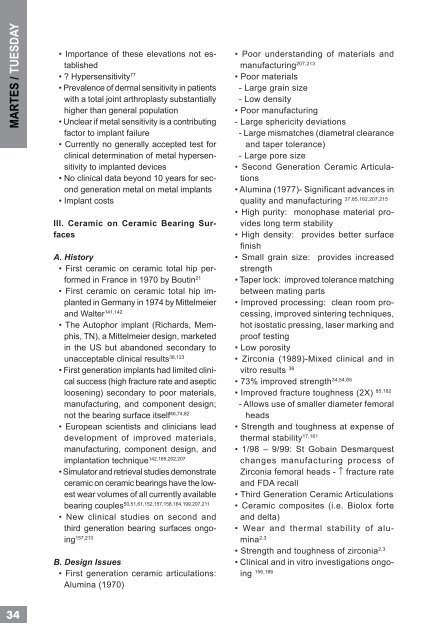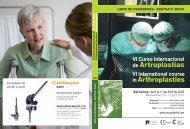cadera / hip - Active Congress.......
cadera / hip - Active Congress.......
cadera / hip - Active Congress.......
You also want an ePaper? Increase the reach of your titles
YUMPU automatically turns print PDFs into web optimized ePapers that Google loves.
MARTES / TUESDAY<br />
34<br />
• Importance of these elevations not established<br />
• ? Hypersensitivity 77<br />
• Prevalence of dermal sensitivity in patients<br />
with a total joint arthroplasty substantially<br />
higher than general population<br />
• Unclear if metal sensitivity is a contributing<br />
factor to implant failure<br />
• Currently no generally accepted test for<br />
clinical determination of metal hypersensitivity<br />
to implanted devices<br />
• No clinical data beyond 10 years for second<br />
generation metal on metal implants<br />
• Implant costs<br />
III. Ceramic on Ceramic Bearing Surfaces<br />
A. History<br />
• First ceramic on ceramic total <strong>hip</strong> performed<br />
in France in 1970 by Boutin 21<br />
• First ceramic on ceramic total <strong>hip</strong> implanted<br />
in Germany in 1974 by Mittelmeier<br />
and Walter 141,142<br />
• The Autophor implant (Richards, Memphis,<br />
TN), a Mittelmeier design, marketed<br />
in the US but abandoned secondary to<br />
unacceptable clinical results 38,123<br />
• First generation implants had limited clinical<br />
success (high fracture rate and aseptic<br />
loosening) secondary to poor materials,<br />
manufacturing, and component design;<br />
not the bearing surface itself 46,74,82<br />
• European scientists and clinicians lead<br />
development of improved materials,<br />
manufacturing, component design, and<br />
implantation technique 142,165,202,207<br />
• Simulator and retrieval studies demonstrate<br />
ceramic on ceramic bearings have the lowest<br />
wear volumes of all currently available<br />
bearing couples 50,51,61,152,157,158,164,199,207,211<br />
• New clinical studies on second and<br />
third generation bearing surfaces ongoing<br />
157,213<br />
B. Design Issues<br />
• First generation ceramic articulations:<br />
Alumina (1970)<br />
• Poor understanding of materials and<br />
manufacturing 207,213<br />
• Poor materials<br />
- Large grain size<br />
- Low density<br />
• Poor manufacturing<br />
- Large sphericity deviations<br />
- Large mismatches (diametral clearance<br />
and taper tolerance)<br />
- Large pore size<br />
• Second Generation Ceramic Articulations<br />
• Alumina (1977)- Significant advances in<br />
quality and manufacturing 37,85,182,207,215<br />
• High purity: monophase material provides<br />
long term stability<br />
• High density: provides better surface<br />
finish<br />
• Small grain size: provides increased<br />
strength<br />
• Taper lock: improved tolerance matching<br />
between mating parts<br />
• Improved processing: clean room processing,<br />
improved sintering techniques,<br />
hot isostatic pressing, laser marking and<br />
proof testing<br />
• Low porosity<br />
• Zirconia (1989)-Mixed clinical and in<br />
vitro results 36<br />
• 73% improved strength 34,54,65<br />
• Improved fracture toughness (2X) 85,182<br />
- Allows use of smaller diameter femoral<br />
heads<br />
• Strength and toughness at expense of<br />
thermal stability 17,161<br />
• 1/98 – 9/99: St Gobain Desmarquest<br />
changes manufacturing process of<br />
Zirconia femoral heads - ↑ fracture rate<br />
and FDA recall<br />
• Third Generation Ceramic Articulations<br />
• Ceramic composites (i.e. Biolox forte<br />
and delta)<br />
• Wear and thermal stability of alumina<br />
2,3<br />
• Strength and toughness of zirconia 2,3<br />
• Clinical and in vitro investigations ongoing<br />
156,186





